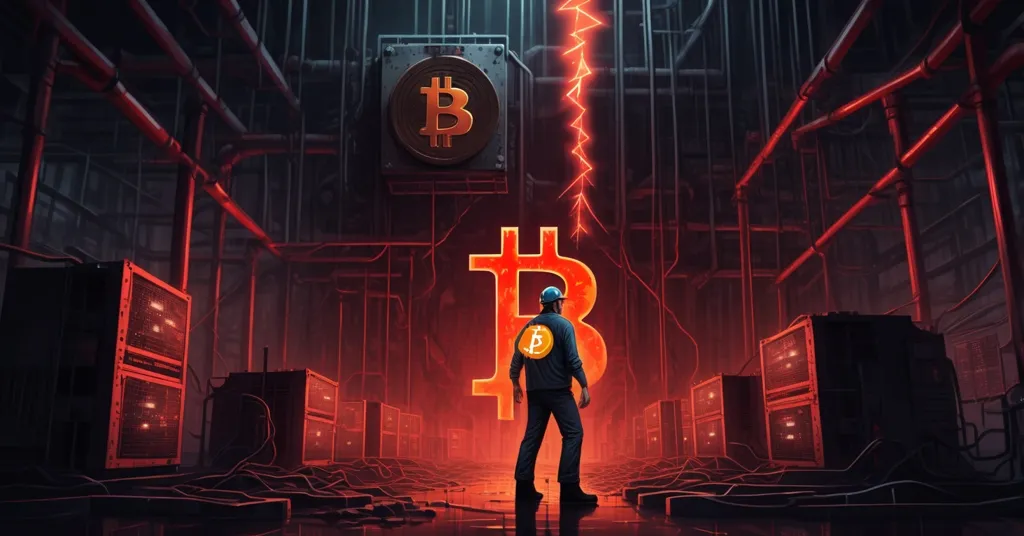Bitcoin Mining Costs Hit $100K: Price Floor or Breaking Point for Miners?

Bitcoin Miners Face New Era As Production Cost Breaks $100K Barrier
Bitcoin mining has entered uncharted territory with the average cost of producing a single BTC surpassing $100,000 for the first time in history. This staggering milestone, driven by skyrocketing energy prices and relentless mining difficulty, is forcing miners into tough choices while Bitcoin hovers near all-time highs around $107,000. As unprofitable operations shut down rather than sell, and the market teeters between breakout and retracement, we’re witnessing a pivotal moment for the king of crypto.
- Bitcoin mining costs exceed $100,000, a historic benchmark signaling a potential price floor.
- Miners are unplugging rigs instead of selling BTC, leading to a 15% hash rate drop that may ease market pressure.
- BTC consolidates between $103,600 support and $109,300 resistance, with muted volume hinting at an imminent move.
Mining Costs Soar to $100K: A Breaking Point
The economics of Bitcoin mining have turned brutal. Analyst Darkfost has flagged a jaw-dropping shift that’s forcing a hard rethink among industry players.
“For the first time in Bitcoin mining history, the average cost of production has surpassed the $100,000 mark,”
Darkfost observes, hinting that this could become a psychological price floor, as detailed in recent analysis by Darkfost on mining costs. Miners, already squeezed, might think twice before selling below their break-even point. But what’s behind this spike? It’s a toxic mix of rising mining difficulty—a metric that adjusts roughly every two weeks to keep block production at about 10 minutes, making it tougher as more computing power joins the network—and energy costs that refuse to relent. In the US, heatwaves have pushed power demand to record highs, with utilities like Con Edison in New York urging conservation as electricity prices hit levels not seen since January. For those new to the game, mining difficulty means the more miners compete to solve cryptographic puzzles and validate transactions, the harder it gets, burning more power and cash.
This $100,000 milestone, explored in depth in reports like those on Bitcoin mining entering a new costly era, hits just months after the April 2024 Bitcoin halving, a programmed event that slashes miner rewards in half every 210,000 blocks (roughly four years) to enforce scarcity and control inflation. Post-halving, miners are earning half the BTC per block while facing operational costs that keep climbing—a gut punch for smaller players. Historically, halvings have often weeded out inefficient rigs while setting the stage for bull runs as supply tightens. But with production costs now neck-and-neck with Bitcoin’s trading price of around $107,000 (a 42% jump from April lows), the margin for survival is razor-thin. Compare this to the 2020 halving aftermath, where costs hovered around $10,000-$15,000 per BTC; today’s numbers show how far the stakes have risen, raising questions about whether this is a typical squeeze or a new, unsustainable reality.
Hash Rate Drops: Miners Play the Long Game
Here’s the twist: despite the financial crunch, miners aren’t flooding the market with their Bitcoin to cover losses. Instead, many unprofitable operations are simply shutting down, leading to a sharp decline in hash rate—a measure of the total computing power securing Bitcoin’s network to verify transactions and add blocks. Data from Blockchain.com shows a 15% drop from a peak of 943.6 billion TH/s in June to 799.9 TH/s recently, the steepest fall in three years, with further insights available on platforms like Reddit discussions about hash rate declines. For newcomers, a lower hash rate means fewer miners are active, which can slow down transaction processing slightly and, in extreme cases, raise theoretical risks of network attacks, though Bitcoin’s scale makes a 51% attack (where one entity controls over half the hash power) highly unlikely for now.
Why shut down instead of sell? It’s a calculated gamble. With profitability gutted by high energy bills and halved rewards, miners are betting on future price surges rather than locking in losses now. This isn’t just about costs—external pressures like grid outages, geopolitical disruptions, and seasonal heatwaves are piling on misery. Yet, this hold-and-halt strategy could be a silver lining for Bitcoin’s price. Less selling pressure from desperate miners means the market might avoid a downward spiral in the short term, as noted in studies on hash rate decline effects on network security. But let’s play devil’s advocate: could this wave of shutdowns signal the death of small-scale mining, handing the reins to corporate giants with deeper pockets? Or might it force a wave of innovation in efficiency and energy use?
Some miners are already adapting. Companies like Marathon Digital and Riot Platforms have started relocating to regions with cheaper, renewable energy—think Iceland’s geothermal power or Canada’s hydropower—or tapping into stranded gas resources to cut costs. This pivot to sustainability isn’t just about profits; it’s a response to growing scrutiny over Bitcoin mining’s environmental footprint. Whether these moves can scale fast enough to save struggling operations remains an open question, but they hint at a future where mining isn’t just a power-hungry beast but a driver of green tech.
Centralization Risks: A Threat to Bitcoin’s Core
While miners adapt, a darker concern looms: centralization. Recent data from ainvest.com reveals that BTC.com Mining Pool funnels 98% of its transfers to Binance, a concentration of power that makes decentralization purists uneasy, with more discussion on this topic at Quora regarding centralization risks in crypto. Bitcoin’s entire ethos rests on a distributed network free from choke points where a single entity—like a massive exchange—could wield outsized influence. This isn’t a new problem; back in 2014, GHash.io briefly controlled over 51% of the hash rate, sparking community outrage and calls for better distribution. Today’s trend with BTC.com raises similar red flags. Are we watching the seeds of a system where mining pools and centralized exchanges undermine the very freedom and privacy Bitcoin stands for?
This is where our championing of decentralization kicks in. Bitcoin’s strength lies in its resistance to control, a middle finger to traditional finance’s gatekeepers. If mining consolidates into fewer hands, or if exchanges like Binance become de facto clearinghouses for miner flows, we risk losing that edge. Community solutions—such as encouraging smaller pools through protocol tweaks or developer advocacy for distributed mining—could counter this, but it’s an uphill battle as mining becomes a capital-intensive game. For now, this centralization risk is a stark reminder that Bitcoin’s fight for independence is far from won.
Price Dynamics: Waiting for a Catalyst
Against this backdrop of miner struggles, Bitcoin’s price action is keeping everyone on tenterhooks. Currently trading around $107,000, BTC is locked in a tight range, with support at $103,600 and a stubborn resistance wall at $109,300. Break above that, and we could see $112,000 or even uncharted price discovery territory, as suggested by recent analysis on Bitcoin breakout potential. Slip below, and the psychological $100,000 level—eerily aligned with that production cost benchmark—might act as a floor. The market structure screams bullish, with key moving averages (50, 100, and 200-day SMAs) stacked between $72,000 and $95,000, showing underlying strength. Institutional flows are holding steady, demand outpaces sell-side pressure, and long-term holders aren’t flinching, all pointing to quiet confidence.
But here’s the rub: trading volume is dead quiet. On-chain transfer volume has dropped 32% to $52 billion, meaning fewer Bitcoins are moving across the network, while spot trading activity on exchanges sits at a paltry $7.7 billion per CoinGecko data, far from the peaks earlier in 2024. It’s so quiet you can almost hear a miner unplugging their last rig. Without a surge in activity, any breakout—up or down—lacks the juice to sustain itself. This price stalemate ties directly to miner behavior, with further context available on mining costs impacting price dynamics. That $100,000 cost threshold could be a make-or-break point for restarting rigs if prices dip, or a green light to HODL if we push higher. But don’t swallow every bullish prediction whole—analysts tossing out $150K targets without volume backing are just playing darts blindfolded. Entertaining, sure, but useless. Real momentum needs real activity, not hot air.
Altcoins in the Mix: Filling Bitcoin’s Gaps
As Bitcoin mining faces these challenges, some capital might eye altcoins with lower energy demands. Take Ethereum, which after its 2022 merge to proof-of-stake slashed its power consumption by over 99%, making it a darling for eco-conscious investors. These systems cater to niches Bitcoin doesn’t—like smart contracts for decentralized apps—offering utility BTC wasn’t built for. That said, let’s not stray too far from our Bitcoin maximalist roots. BTC remains the gold standard of crypto, unmatched in security, scarcity, and store-of-value cred, as outlined in resources like the Wikipedia entry on Bitcoin mining. Altcoins play their part in this financial revolution, but Bitcoin’s the bedrock. The question is whether mining woes could temporarily divert attention to these other ecosystems, even as BTC holds the crown.
What’s Next for Bitcoin and Miners?
Bitcoin stands at a crossroads, both economically and philosophically. Miners grappling with $100,000 production costs are rewriting the rulebook, while the market hovers on the brink of a defining move. A hash rate drop might curb sell pressure for now, but are we just delaying a reckoning as smaller players get squeezed out? Can Bitcoin cling to its rebellious, decentralized spirit as mining consolidates? And let’s not just ride the hype wave—dig into the data. Are miners signaling strength by holding, or are they simply out of options? Let’s unpack this with some key questions and takeaways.
- What does a $100,000 Bitcoin mining cost mean for price stability?
It could create a psychological floor near $100,000, as miners may balk at selling below their break-even, potentially propping up Bitcoin’s value. - Why are Bitcoin miners shutting down rigs instead of selling coins?
High energy costs and halved rewards post-2024 halving have crushed profitability, so many miners are pausing operations and betting on future gains rather than taking losses now. - Which Bitcoin price levels signal a breakout or breakdown in 2024?
Watch $109,300 as key resistance; surpassing it could drive BTC to $112,000 or beyond. Below $103,600 support, $100,000 becomes the next test. - Is current Bitcoin market sentiment strong enough for new highs?
Long-term holder resilience and institutional interest are bullish, but low trading volume and on-chain activity mean a breakout needs a major participation spike to stick. - How do centralization risks in mining pools threaten Bitcoin’s ethos?
Concentration of miner flows, like BTC.com’s 98% reliance on Binance, risks creating power choke points, challenging Bitcoin’s promise of a censorship-resistant, distributed network. - Could Bitcoin mining challenges push investors toward altcoins?
Rising costs might divert some capital to energy-efficient altcoins like Ethereum, though Bitcoin’s unique security and scarcity keep it the cornerstone of crypto.
As we navigate this new era, the dance between miner economics and market momentum will shape Bitcoin’s path. The promise of disrupting traditional finance—rooted in freedom, privacy, and decentralization—burns bright, but it’s tested by soaring costs and centralization pressures. For now, miners are holding the line, and the market holds its breath. Whether we’re on the cusp of a breakout or a rude awakening, one thing’s clear: the next chapter of this financial rebellion is unfolding fast. Stay sharp.



